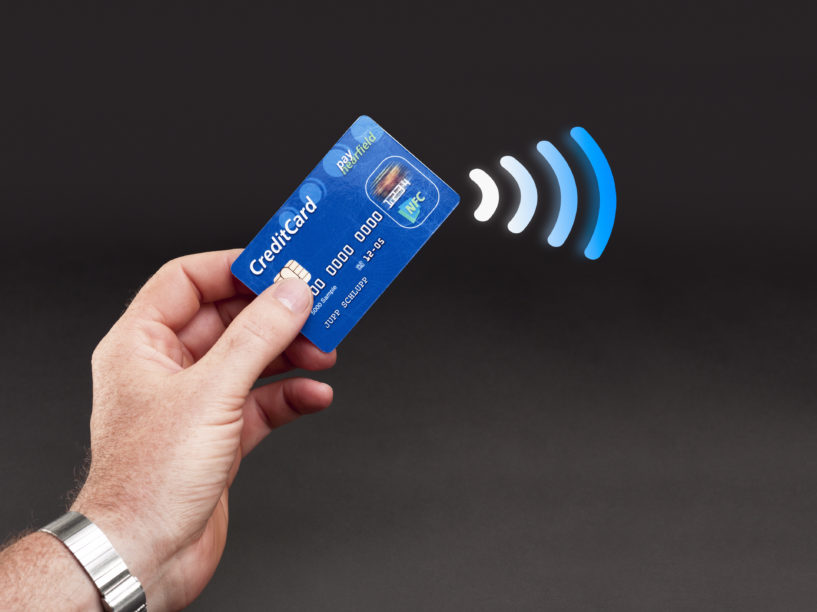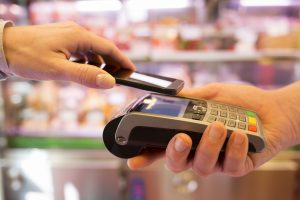
 If you’ve ever been waiting in line to pay and seen a customer wave or tap her debit card near a payment terminal to buy something, you’ve seen contactless payment. Many stores are moving to make payment easier for their customers—by eliminating the need for cash and allowing payment with a variety of devices, including everything from iPhone and Android smartphones to wearable devices primarily used for fitness tracking.
If you’ve ever been waiting in line to pay and seen a customer wave or tap her debit card near a payment terminal to buy something, you’ve seen contactless payment. Many stores are moving to make payment easier for their customers—by eliminating the need for cash and allowing payment with a variety of devices, including everything from iPhone and Android smartphones to wearable devices primarily used for fitness tracking.
These transactions are possible because of something called near-field communication (NFC), a special payment technology that allows a card to receive and transmit information securely over a short distance when the cardholder makes a payment. Only requiring about 4 cm of distance between the card and card reader, NFC is fast and easy, allowing purchasers the ability to move through more quickly without entering a pin number and without requiring a signature.
Although contactless transactions are gaining in popularity and are an improvement to radio-frequency identification (RFID), many cardholders still question the security and benefits of contactless transactions.
Benefits of Contactless Payment
- Paying is fast and convenient. Most new mobile phones, smart watches, fitness trackers, and some commercial key fobs are enabled with NFC technology. Users also spend less time waiting at the register by using tap and
 pay rather than swiping a card and using a pin or signing for a payment.
pay rather than swiping a card and using a pin or signing for a payment. - In some ways, it’s more secure. Contactless debit (and credit) cards that contain NFC technology have layers of security, using encrypted data to transmit a unique transaction number.
- The card number isn’t used for the payment and merchants don’t use or store the card information in their POS terminal, so there’s less likelihood of a debit number being used in fraudulent transactions after being compromised in a data breach.
- Since cardholders don’t swipe, they also avoid fraudsters who collect data from gas station pumps, ATMs and other public terminals.
Challenges of Contactless Payment
- Although contactless payment cards have been used globally for a long time, many issuers in the US are just now getting on board, so contactless payment isn’t accepted at every terminal yet. Users would need to know ahead of time which merchants are able to accept contactless payment and which ones require more
 conventional payment methods.
conventional payment methods. - Card issuers are working to raise awareness and make transactions easier, but some consumers may be confused by the new technology and how to use it.
- Many companies have a transaction limit, so users might still have to use a conventional payment method for larger purchases. Users should research their transaction limit by contacting the issuer ahead of time.
- Although the technology is improving, occasionally the connection may be poor, requiring a customer to swipe or sign anyway. Users would need to be prepared ahead of time with an alternate payment method.
- With the use of smartphones or wearable devices for contactless payment, it’s easier for the actual debit card to become lost or stolen.
Summary
For customers who make a lot of quick, digital payments as part of a daily routine, using contactless payment makes sense—it’s faster, allows users to multitask with capability on other devices, and is a more secure transaction in many ways. For larger, more calculated purchases or in situations where a connection may be tenuous, it’s a good plan to have a debit card or credit card available for more conventional use (swiping or inserting). Users should speak with their issuing bank and research the specific form of contactless payment that may works for their use. Although it’s a complex technology, contactless payment has the ability to bring simplicity to many aspects of customer transactions.
sense—it’s faster, allows users to multitask with capability on other devices, and is a more secure transaction in many ways. For larger, more calculated purchases or in situations where a connection may be tenuous, it’s a good plan to have a debit card or credit card available for more conventional use (swiping or inserting). Users should speak with their issuing bank and research the specific form of contactless payment that may works for their use. Although it’s a complex technology, contactless payment has the ability to bring simplicity to many aspects of customer transactions.
Latest Posts
March 4, 2020
February 27, 2020
CATEGORIES

